Military History – Ferrybarns Naval Airstation
Kite Balloons
Battlefield Observation Balloons have been used since the middle of the 19th century. Initially these were spherical balloons, tethered by a cable, carrying an observer in a basket.
While these proved to be useful, the spherical balloon was free to spin round on its cable, making observation difficult. In windy conditions the balloon was dragged around, and would not gain any altitude when its tethering cable was extended.
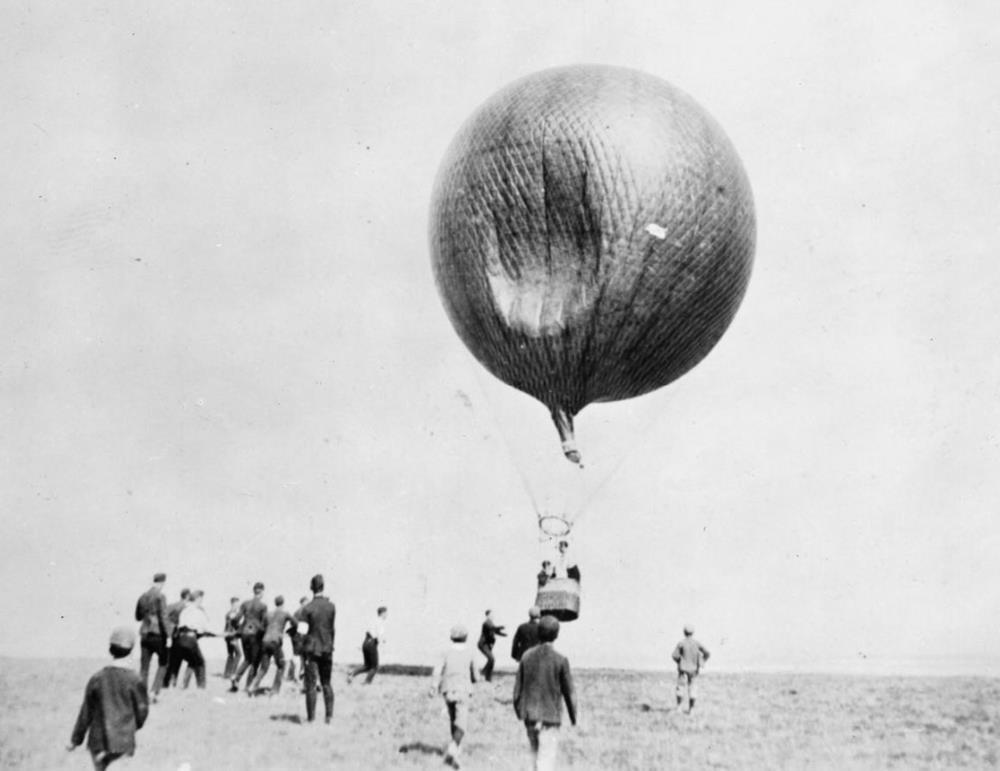 A spherical observation balloon
A spherical observation balloon
The kite balloon was designed to overcome these problems. It is cigar shaped, with fins at the rear, so it will fly into the wind, this makes observation much more comfortable. By adjusting the position of the tether cable, to keep the nose up, the balloon acts like a kite and will fly into the wind or the slipstream when towed behind a ship.
The outbreak of World War I gave a great impetus to balloon development. For some time both the German and Allied armies made use of the Drachen type of kite balloon. It could be flown in winds approaching 60 miles an hour while the spherical balloon was quite unmanageable in a wind of only 20 miles an hour.
But the Drachen balloon left much to be desired for flying in really high winds. The steep angle of flight necessary for the kiting effect presented a large surface to the wind which caused great strain to be put on the cable and snapping often happened. At home, efforts were made to produce a balloon for flying in winds up to 90 miles an hour and eventually Capt. Caquot of the French Army designed the streamlined kite three-tailed balloon which became the standard observation balloon in the British and French Armies and for the British Naval forces.
Kite Balloons at Sea
On 11th March 1915 the cargo ship SS “Manica” was hired by the Admiralty – at a time she was unloading a cargo of manure from Australia. Now HMS Manica, she was equipped as a balloon-carrying ship and despatched to Gallipoli for spotting and directing gunfire from the sea. So valuable was the balloon for this work that further ships were equipped as balloon-carriers and eventually some of the cruisers of the main battle fleet were equipped with the balloon.
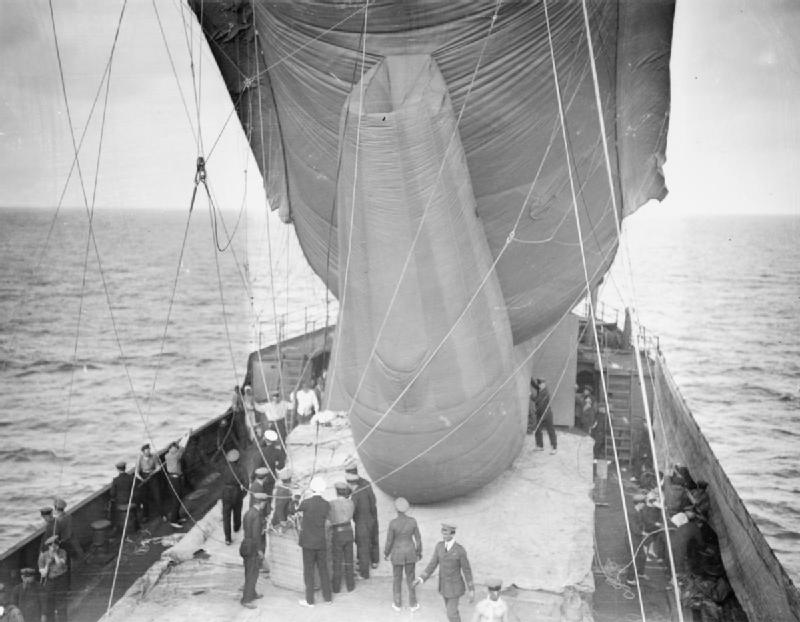
A ‘Drachen’ type balloon is held steady aboard HMS Manica, while its observer waits to climb into the basket, off the Gallipoli coast, summer 1915.
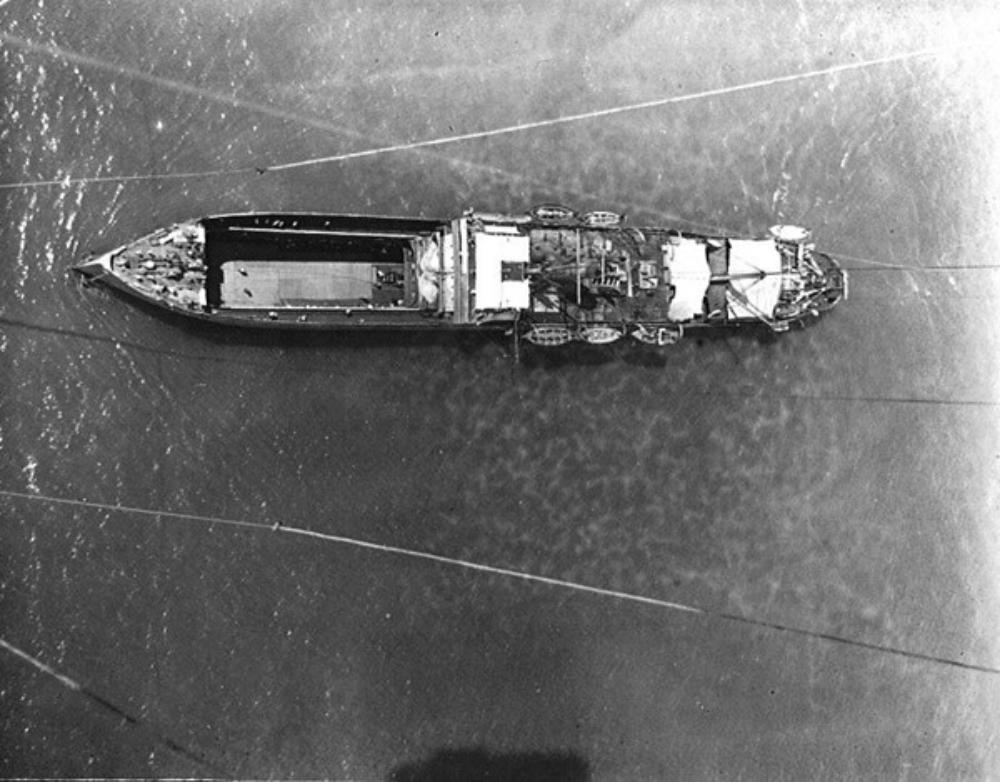 A view of HMS Manica from the basket of the kite balloon. Note the open forward bay for storage, inflation and launch.
A view of HMS Manica from the basket of the kite balloon. Note the open forward bay for storage, inflation and launch.
After the Battle of Jutland [June 1916] . . .
. . . Vice-Admiral Beatty, in his report of the proceedings of the Battle Cruiser Fleet, stated — “I would submit that the balloon should be flown from a ship in the advanced cruiser screen in order to increase the range of vision ahead of the Fleet. Had the kite balloon been well forward during the operations, I am of opinion that the enemy might possibly have been sighted.”
. . .in view of the proved value of kite balloons towed from ships, Admiral Jellicoe had asked, early in June [1916], for eleven balloons, one for each battle squadron and battle cruiser flagship, and two for use in the light cruiser squadrons. On the 30th of September [1916] he increased his demands to twelve balloons of the latest ‘M’ type, [of Caquot balloon] complete with spares.
The proposal received Admiralty approval on the 13th of October, and shore bases to house the balloons and to supply them ready-inflated to the ships as required, were begun at Scapa and North Queensferry. The stations were completed early in 1917.
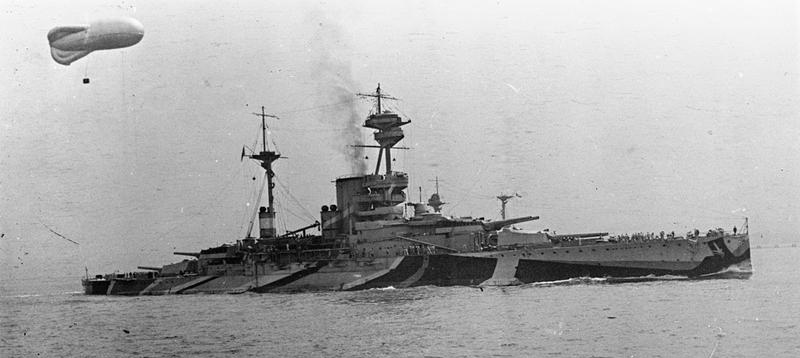 HMS Revenge flying a Kite Balloon
HMS Revenge flying a Kite Balloon
North Queensferry Kite Balloon Station
The North Queensferry kite balloon station was opened in the summer of 1917 on a cramped site to the west of the Forth Rail Bridge, near the Rosyth Naval Base. In the 1918 RAF survey of aerodromes it was described as ‘Marine Operations (Balloon Station), No. 18 Balloon Base’ under the command of the Vice-Admiral commanding the Second Battle Squadron. The base had eight balloons housed in large canvas hangars, and had an establishment of 216 men, some housed in huts on site, others in the house known as ‘Ferry Craig’ which was requisitioned for the purpose.
The kite balloon stations closed shortly after the end of the war and the role of kite balloons was taken over by aircraft carrier-borne aircraft and seaplanes. There is no trace of the airship station today, the site has been built over.
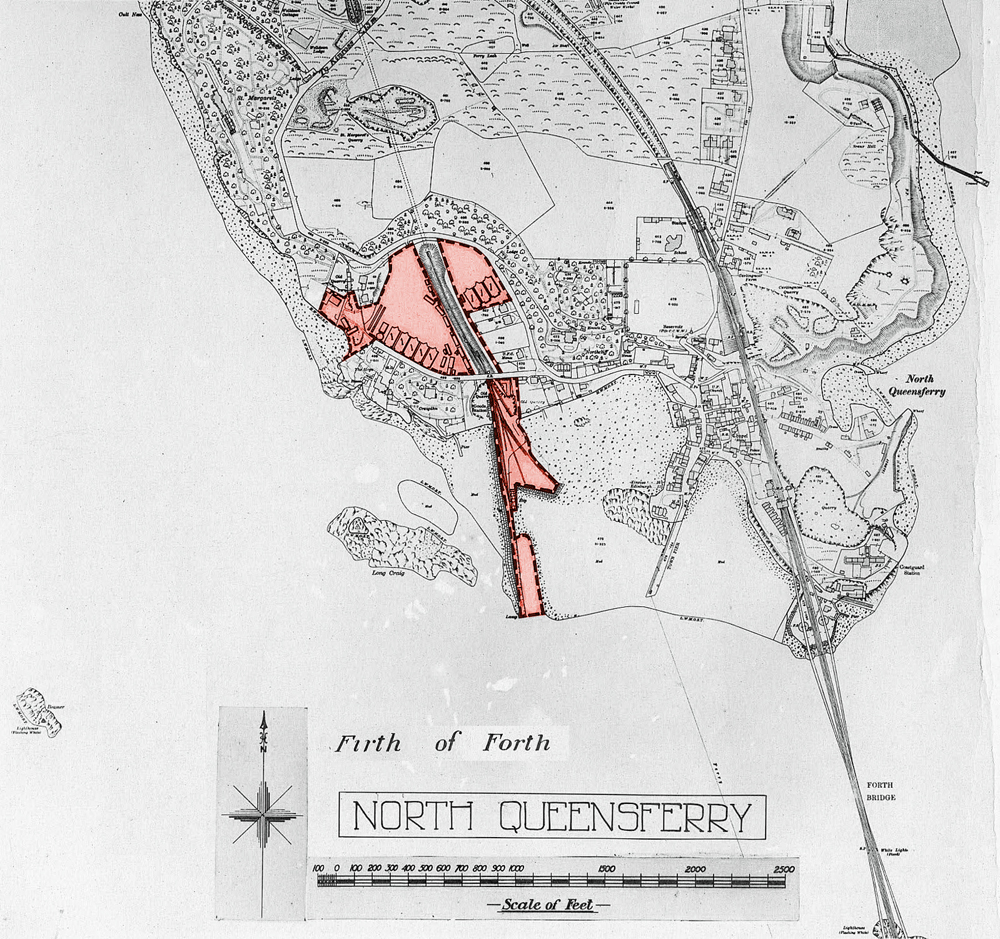
1918 map of the Air Station at Ferrybarns
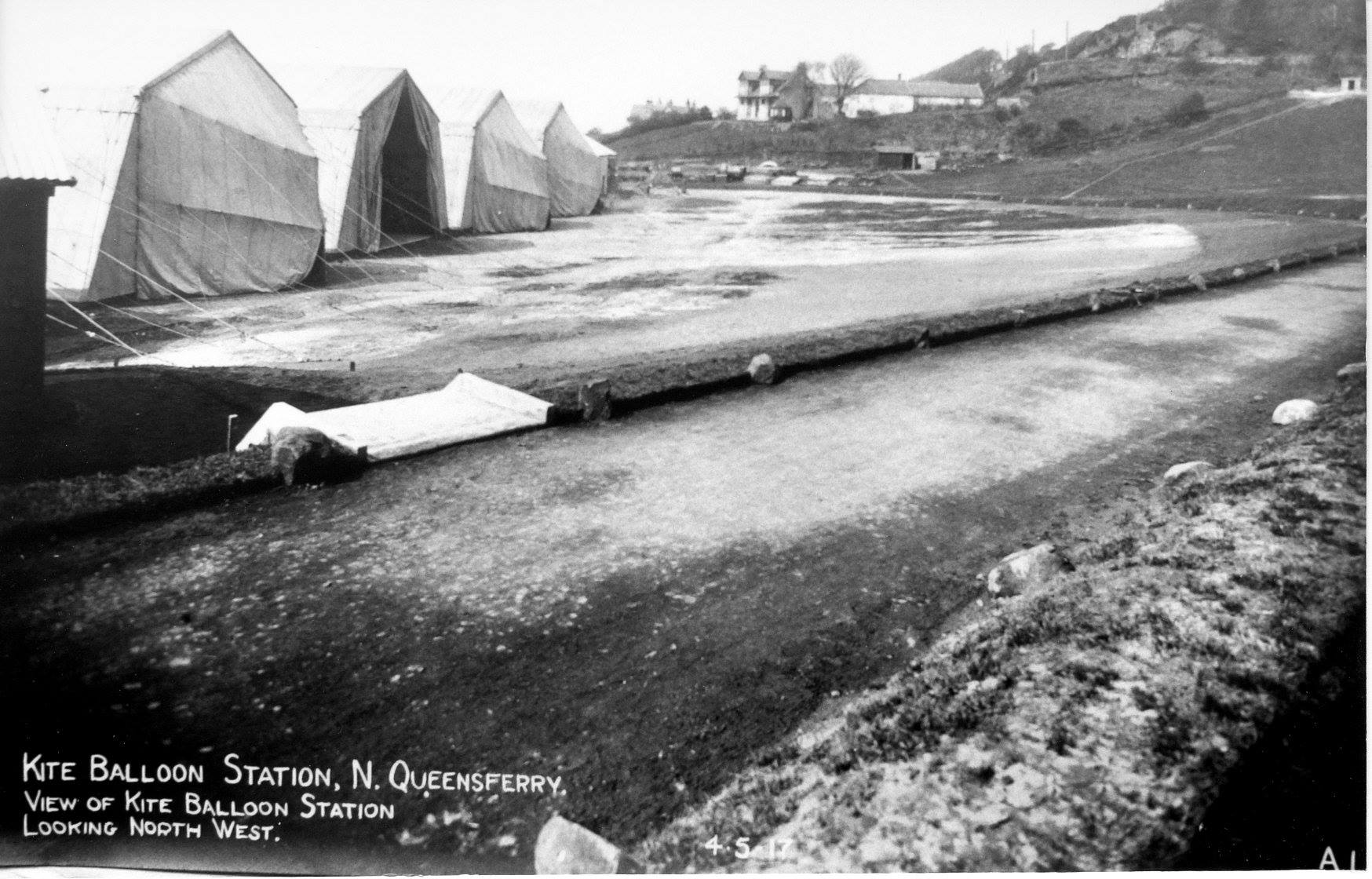
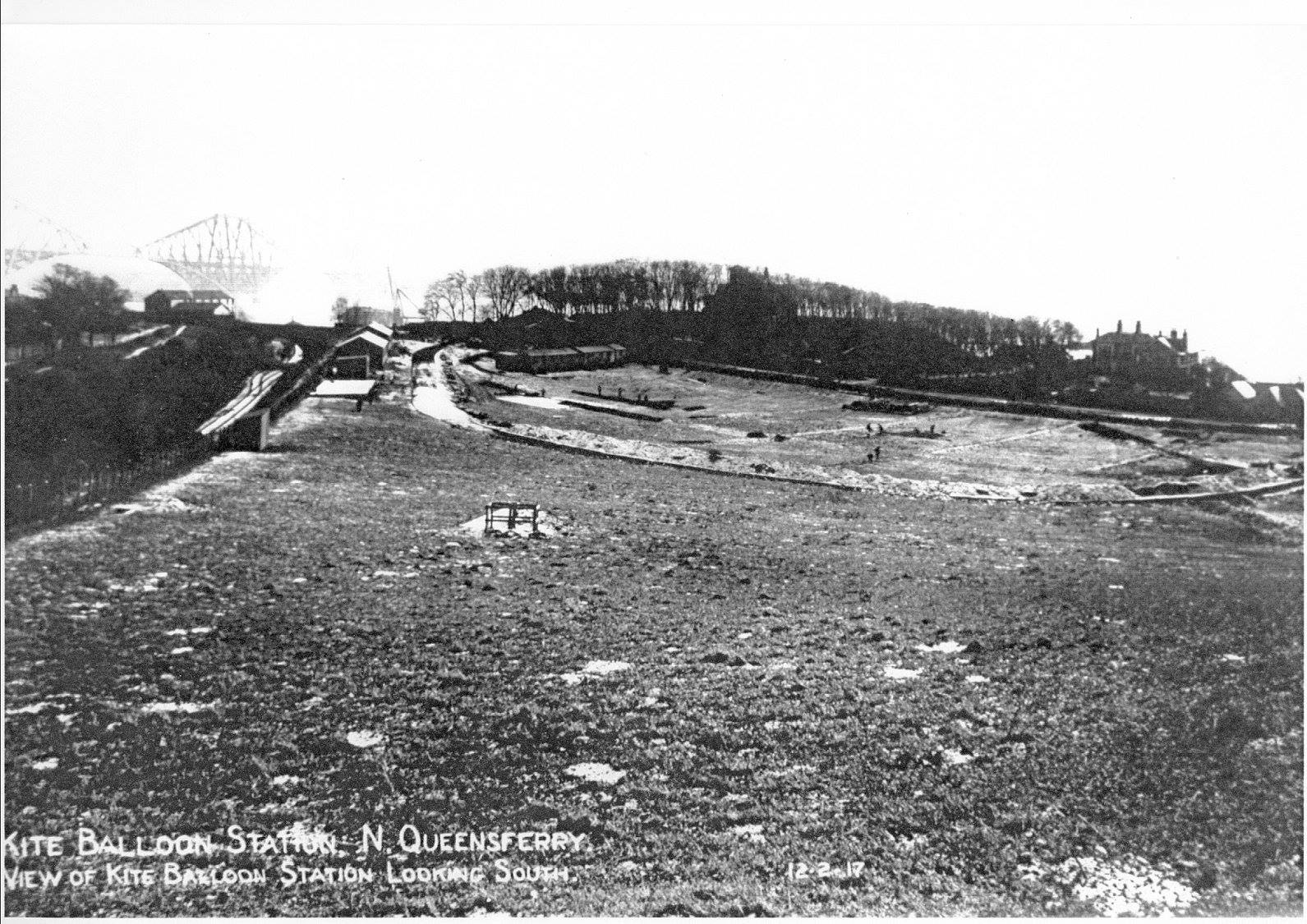

The balloons were inflated on shore, then taken out to warships in the Forth by lighters. Once transferred, The balloons were held down on the aft deck of the war ships by winch cable, and secured with lashings. Once the ship had passed under the Forth Bridge, the balloon could be allowed to ascend on the winch cable, with an observer in the basket communicating by telephone to the ship below.
 Officers and men of the recently established kite balloon station are lined up for inspection by the Commander-in-Chief on 4th May 1917.
Officers and men of the recently established kite balloon station are lined up for inspection by the Commander-in-Chief on 4th May 1917.
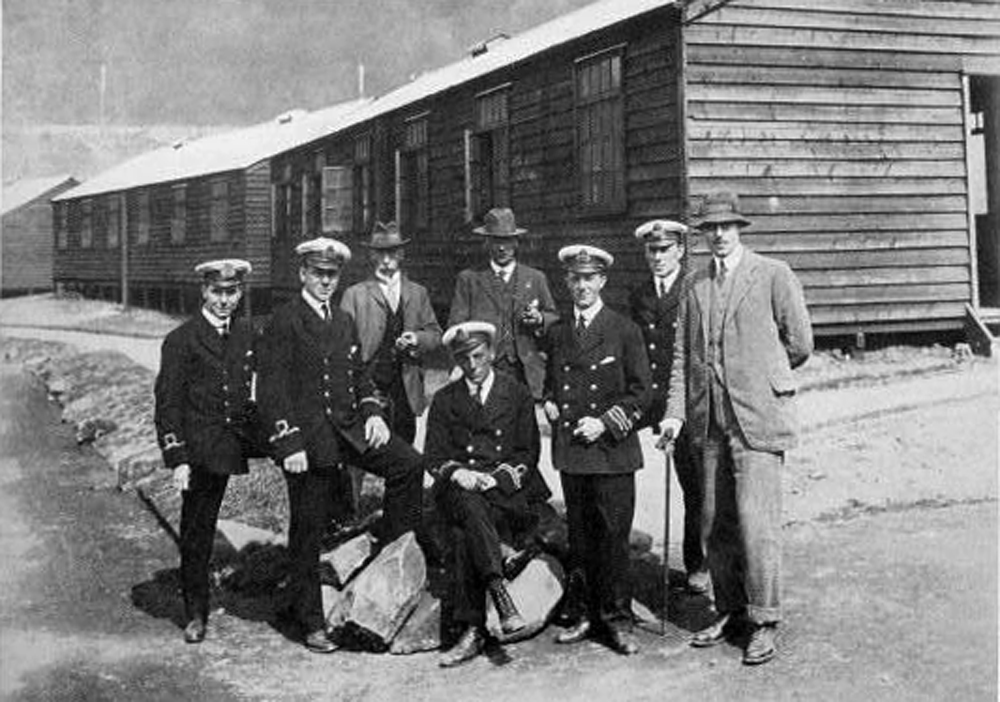 Officers in front of a group of wooden huts used for accommodation of personnel. The men in civilian clothes were probably the building contractors. (The section below on disposal gives more details of the huts.)
Officers in front of a group of wooden huts used for accommodation of personnel. The men in civilian clothes were probably the building contractors. (The section below on disposal gives more details of the huts.)
Painting by Sir John Lavery
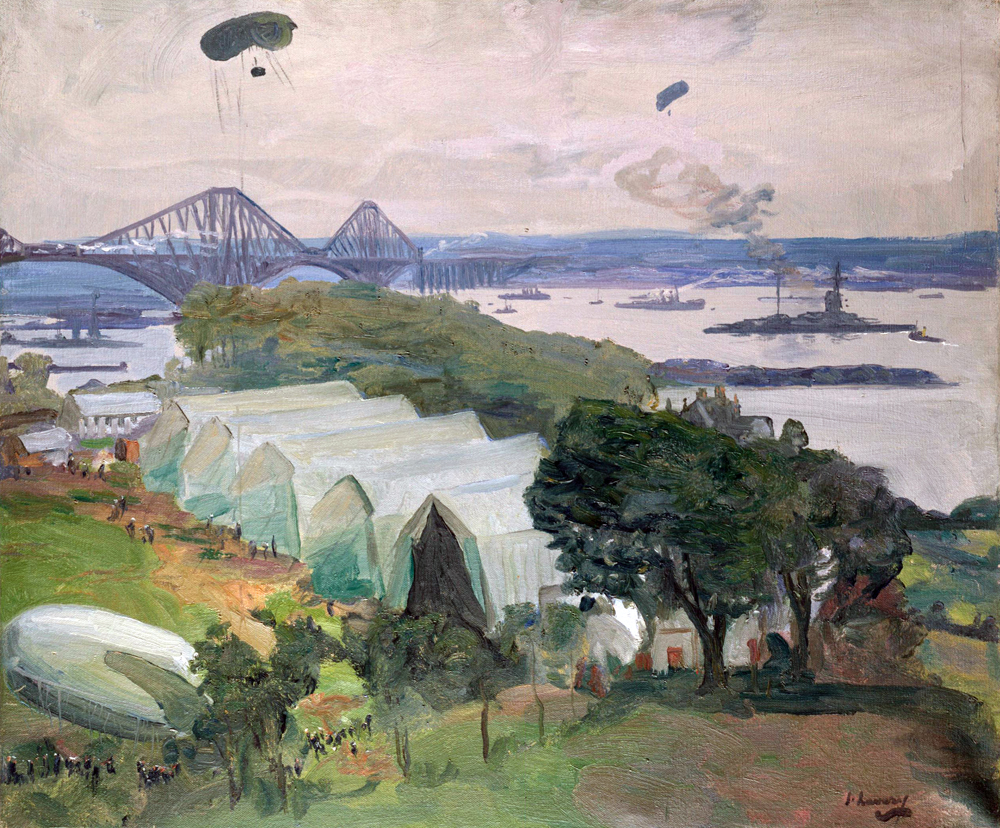 This painting of the Air Station hangs in the Scottish National Portrait Gallery
This painting of the Air Station hangs in the Scottish National Portrait Gallery
Air Station, North Queensferry, 1917
Creator: Sir John Lavery (1856-1941) (artist)
Creation Date: 1917
Materials: Oil on canvas
Dimensions: 63.5 x 76.6 cm
Description: This war picture is a rare example of a modernist British painting in George V’s collection. It was a Silver Wedding present to the King and Queen Mary on 6th July 1918 from members of the royal family. The painting was purchased by Prince Arthur, Duke of Connaught, for 75 guineas on behalf of his four surviving sisters. A month earlier he had written to Princess Louise, ‘I have found a very interesting and cleverly painted war picture by Sir John Lavery which I am sure they will like; it has been difficult to find a good modern picture by a well-known artist at a moderate price’. The King’s reaction to this enlightened choice of gift is unrecorded.
Both King and artist made numerous wartime visits to the Grand Fleet, based in the Firth of Forth and at Scapa Flow. In June 1917 the King devoted a week to its inspection.
Lavery, then 61 years old was an official war artist restricted to the Home Front, travelling widely to record naval activities. Some dozen canvases resulted from Lavery’s fortnight’s stay in Edinburgh in September 1917, depicting principally the Grand Fleet, the Forth Bridge and local military installations.
Air Station, North Queensferry shows the temporary airfield east of Rosyth, which had been recently transferred by the Royal Flying Corps to the Royal Naval Air Service. It was established to support the warships of the Grand Fleet.
Lavery’s picture, although freshly and fluidly painted, is likely to have been worked on in his London studio as it was not ready for inspection by the Chief Naval Censor in November 1917. The reverse of the canvas still bears the censor’s red paint inscriptions.
Despite his frustrations at being kept from the Front, Lavery’s search for subjects extended the range of the war artist. He was one of the first artists to take to the air, in August 1918, making studies from an airship for a picture of a North Sea convoy. Earlier that year, recently knighted, he braved Arctic conditions in a heated airman’s suit to make swift sketches of Scapa Flow.
He donated the majority of his naval war pictures to the Imperial War Museum in 1918. Deeply supportive of younger war artists, Lavery denigrated his own wartime achievement, stating, ‘I felt nothing of the stark reality, losing sight of my fellow men being blown to pieces in submarines, or slowly choking to death in mud. I saw only new beauties of colour and design.’
Disposal of the buildings – April 1920
The balloon hangers and other buildings were put up for sale (along with other material from the Anti Aircraft station on Ferryhills) on April 15th 1920
The Scotsman – Wednesday 7th April 1920 – Page 12
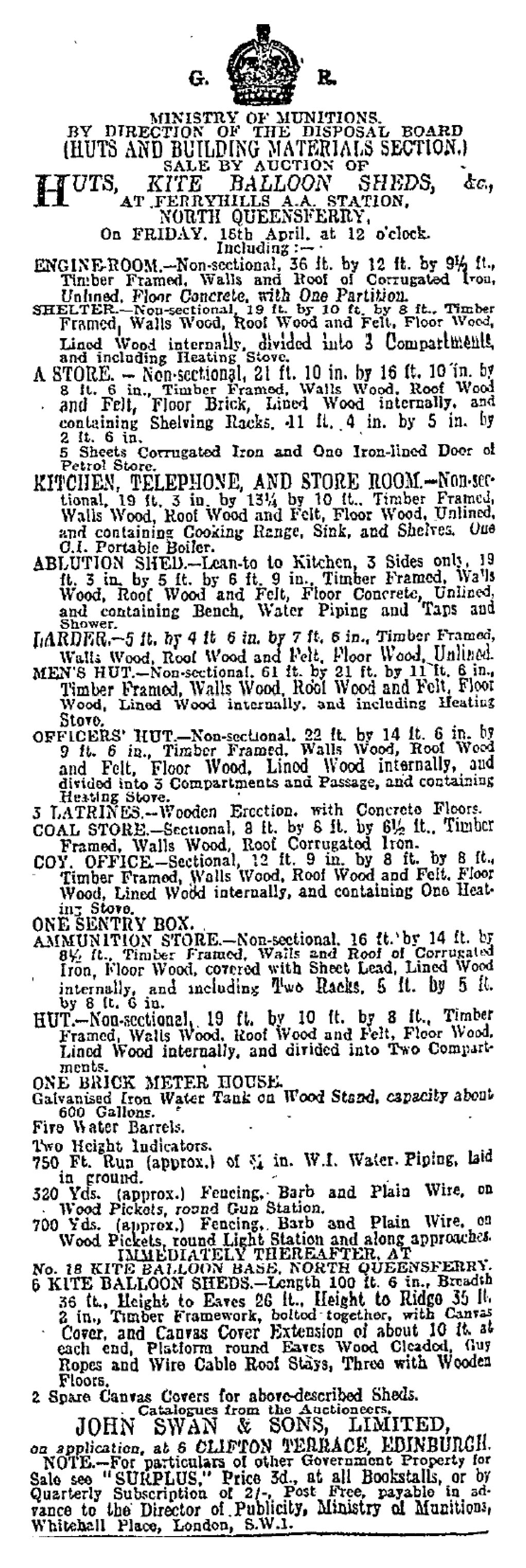
Census Records – June 1921
When the census was taken on Sunday 19 June 2921, there were 45 enlisted men living at “29 Headquarters, Fleet Group RAF (Hutments)” – i.e. the Ferry Barns Air Station.
The RAF was founded on 1 April 1918, towards the end of the First World War by merging the Royal Flying Corps and the Royal Naval Air Service. So by June 1921 it was operating the Kite Balloons of the Grand Fleet from Ferry Barns.
No 29 Group RAF, was briefly formed as No 29 (Training) Group in Egypt in early November 1918. Reformed on 27 November 1918 as No. 29 (Operations) Group under Commander-in-Chief of the Grand Fleet. Renamed No. 29 (Fleet) Group in August 1919. Transferred to Coastal Area on 15 September 1919, and disbanded on 31 March 1922.
In charge was RAF Group Captain Robert Clark Hall (later Air Marshal Sir Robert Clark-Hall) living with his wife and family in Craigdhu. One RAF Officer and his family were living on Craigdhu Cottage, while three RAF Officers were living in Ferry Craig house.
The occupation of Ferry Craig by the Air Ministry had been raised in Parliament in August 1920 – as recorded in Hansard
“FERRYCRAIG,” NORTH QUEENSFERRY.
HC Deb 11 August 1920 vol 133 c412W412W
Mr. WALLACE asked the Secretary of State for Air whether the Air Ministry intend to vacate the house Ferrycraig, North Queensferry, and, if so, at what date; whether he is aware that correspondence between the Air Ministry and the agents of the owner of the House has been proceeding since 5th March without result; and if it is within his knowledge that there is alternative accommodation in the district standing vacant?
Mr. CHURCHILL I am aware that representations with regard to this matter have been made to the Air Ministry, but I am unable at present to say whether this house will be vacated. The alternative accommodation referred to in the third part of the question is the property of the Admiralty, and the possibility of utilising it in place of the house in question is being investigated. Every effort is being made to arrive at an early decision.
Boyd Williamson, March 2018 – updated July 2021, and May 2023.